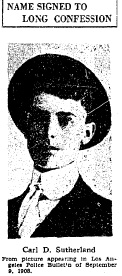
Glendale
February 19, 1927
On the morning of September 9, 1908, 26-year-old career criminal Carl D. Sutherland shot and killed Los Angeles police Captain W.H. Auble in the course of a robbery gone bad. Two thousand people participated in the manhunt that followed. That night, Sutherland was tracked to the brush near the city limits. Surrounded by police, he threw down his revolver, then drank the contents of a vial of cyanide that hung from his neck. Officers had just enough time to place cuffs on his wrists before Sutherland fell to the ground, dead. The next day’s headline read: “Killer of Brave Officer Takes His Own Worthless Life.”
Today, nineteen years after Sutherland shot Captain Auble and committed suicide, a Glendale man searching under his house for his dog found a box half buried in the dirt. In it was a 50-page handwritten document in which the cop killer confessed to dozens of other crimes, including burglaries, train and stage coach robberies, as well as a plan to kidnap a California pioneer businessman who once criticized Sutherland when he worked as a waiter. An attached note was addressed to Jack Hendrickson, who, in 1908, was an L.A.P.D. officer Sutherland considered honest.
The son of the first City Marshal of Pittsburgh, Kansas, Sutherland was no Confessing Sam; he was a hardened criminal who for unknown but probably psychological reasons had a need to confess his misdeeds without actually taking responsibility for them--hence the vial of cyanide. He hoped the confession would be published and some of the proceeds given to his wife. Nobody knew how or why the document turned up under the house at 209 North Columbus Avenue in Glendale.
Another mystery, not mentioned by the Times in 1927, is that when Sutherland’s body was searched shortly after his death, police found a number of stamped and addressed letters. Among them was “a remarkable history of Sutherland’s life as set forth by himself. It covered fifty pages of manuscript,” reported the Times in 1908. The Times published copious portions of that document, which was also addressed to Jack Hendrickson and referenced the planned kidnapping. Was the document found in 1927 a copy of the 1908 letter, hidden by Sutherland or one of his cronies lest the letter go astray? Was it a separate document? How did Sutherland have the time to pen two fifty-page documents after killing Captain Auble in the morning and his own death that evening? Why didn’t the police in 1927 realize how similar the newly discovered confession was to the letter they presumably read in 1908?
As of February 1927, the police were busy checking their list of unsolved crimes against Sutherland’s confession.
